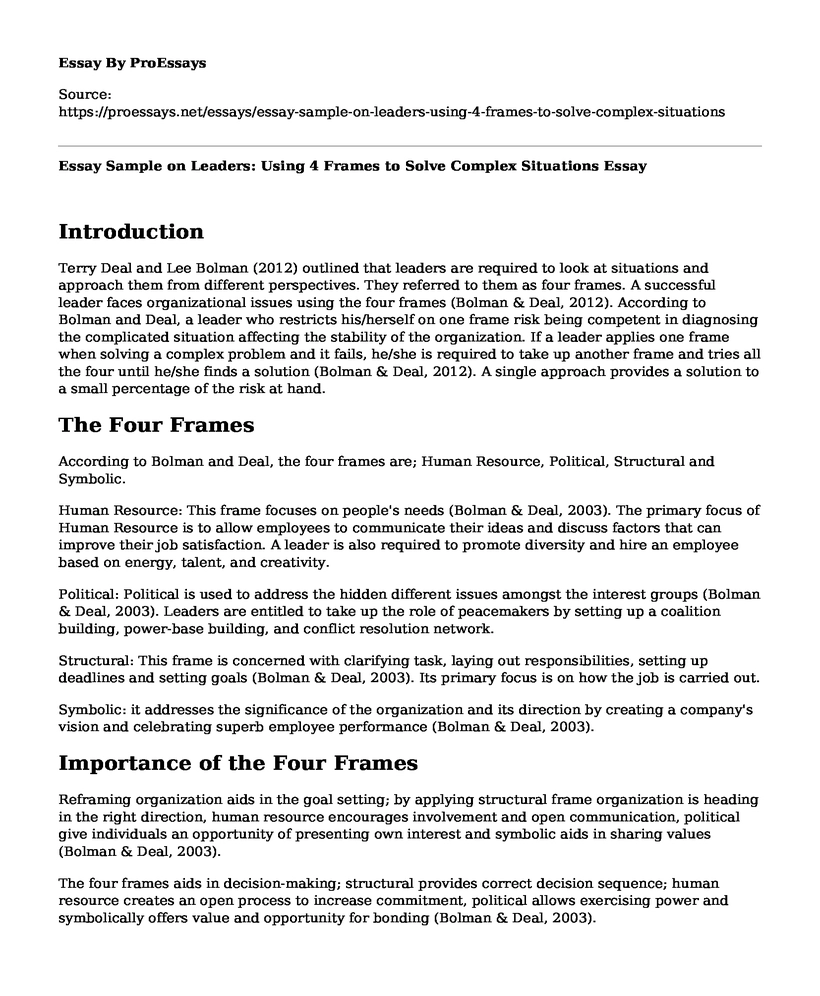Introduction
Terry Deal and Lee Bolman (2012) outlined that leaders are required to look at situations and approach them from different perspectives. They referred to them as four frames. A successful leader faces organizational issues using the four frames (Bolman & Deal, 2012). According to Bolman and Deal, a leader who restricts his/herself on one frame risk being competent in diagnosing the complicated situation affecting the stability of the organization. If a leader applies one frame when solving a complex problem and it fails, he/she is required to take up another frame and tries all the four until he/she finds a solution (Bolman & Deal, 2012). A single approach provides a solution to a small percentage of the risk at hand.
The Four Frames
According to Bolman and Deal, the four frames are; Human Resource, Political, Structural and Symbolic.
Human Resource: This frame focuses on people's needs (Bolman & Deal, 2003). The primary focus of Human Resource is to allow employees to communicate their ideas and discuss factors that can improve their job satisfaction. A leader is also required to promote diversity and hire an employee based on energy, talent, and creativity.
Political: Political is used to address the hidden different issues amongst the interest groups (Bolman & Deal, 2003). Leaders are entitled to take up the role of peacemakers by setting up a coalition building, power-base building, and conflict resolution network.
Structural: This frame is concerned with clarifying task, laying out responsibilities, setting up deadlines and setting goals (Bolman & Deal, 2003). Its primary focus is on how the job is carried out.
Symbolic: it addresses the significance of the organization and its direction by creating a company's vision and celebrating superb employee performance (Bolman & Deal, 2003).
Importance of the Four Frames
Reframing organization aids in the goal setting; by applying structural frame organization is heading in the right direction, human resource encourages involvement and open communication, political give individuals an opportunity of presenting own interest and symbolic aids in sharing values (Bolman & Deal, 2003).
The four frames aids in decision-making; structural provides correct decision sequence; human resource creates an open process to increase commitment, political allows exercising power and symbolically offers value and opportunity for bonding (Bolman & Deal, 2003).
It helps in strategic planning; structural frame coordinate resources, Human resources held gatherings for public participation, political provides an arena for airing power grievances and symbolic signals responsibility and negotiate meanings (Bolman & Deal, 2012).
Framing acts as a tool of motivation; structural frame outlines economic incentives, human resources promote self-actualization, political aids in coerced manipulation and symbolic aids celebrations (Bolman & Deal, 2012).
References
Bolman, L., & Deal, T. (2003). Reframing Organizations: Artistry, Choice, and Leadership (Jossey-Bass higher and adult education series). Jossey Bass Inc.
Bolman, L., & Deal, T. (2012). Reframing organizations. Johanneshov: TPB.
Cite this page
Essay Sample on Leaders: Using 4 Frames to Solve Complex Situations. (2023, Jan 04). Retrieved from https://proessays.net/essays/essay-sample-on-leaders-using-4-frames-to-solve-complex-situations
If you are the original author of this essay and no longer wish to have it published on the ProEssays website, please click below to request its removal:
- Collaboration Leadership in Development of a Mental Health Care Agency
- Stolen Without a Gun Ethics Essay
- Leadership and Motivation of School Employees Essay
- Jury and Work Group Decision Making Essay
- Essay Sample on Effective Leadership: Determining the Success of an Organization
- Paper Example on Leadership: Strategies for Successful People Management
- Paper Example on Management History and Theories







